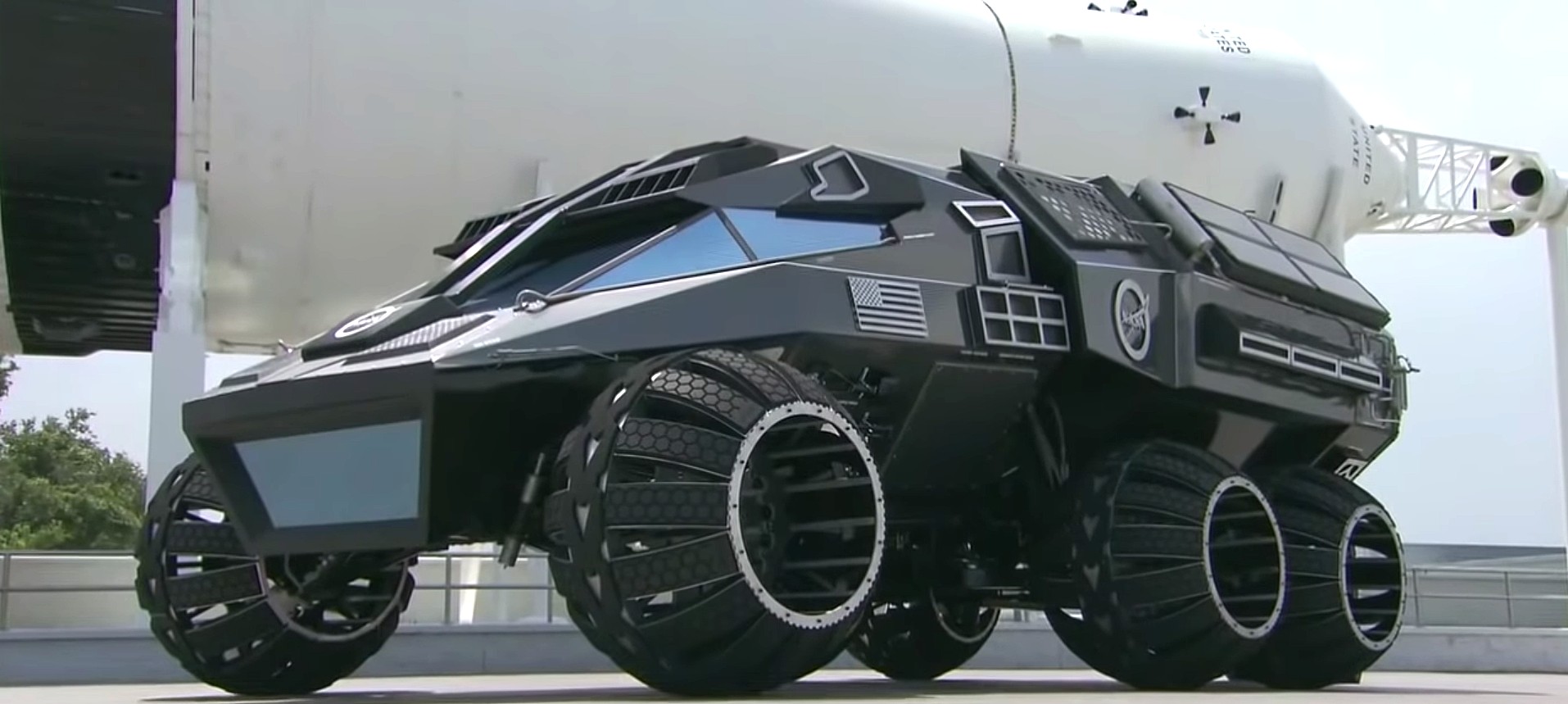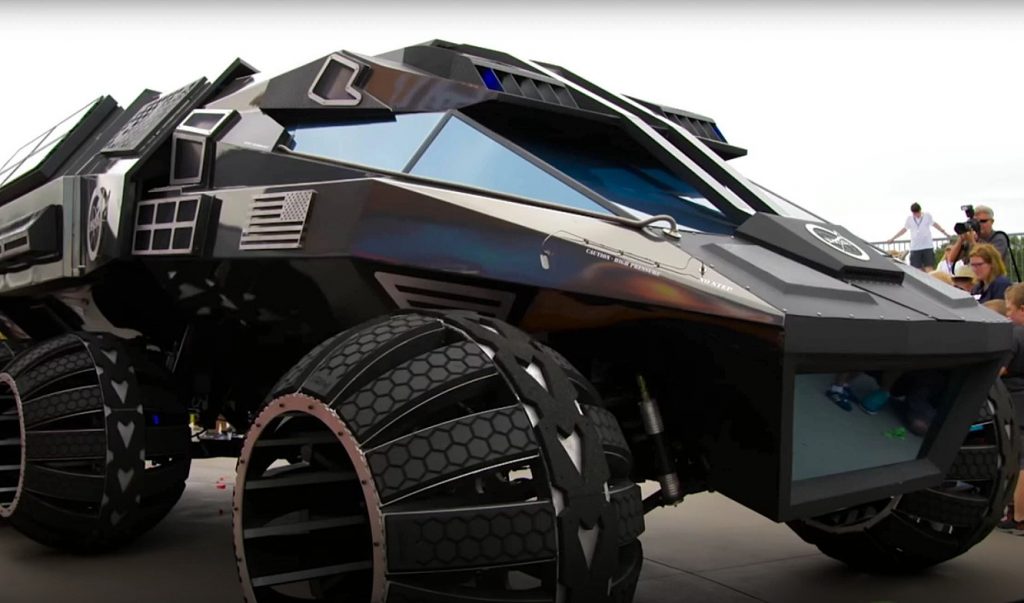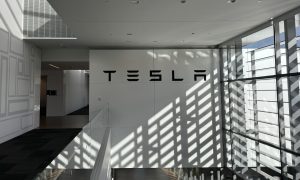

News
Tesla Cybertruck sure looks similar to NASA’s Mars rover concept
Elon Musk’s “Blade Runner” Cybertruck may only be a couple days away from being unveiled to the world, but the vehicle, from its final specs and design, remains a mystery. The Tesla CEO has stated that the vehicle will not look like a traditional pickup truck, and this has been confirmed by teasers from the company and clever Easter Eggs hidden in the CYBRTRK event’s invitation and the vehicle’s stylized logo.
Considering that Musk has stated that the Tesla Cybertruck will look like an armored personnel carrier (APC) from the future, it’s difficult to not see the potential similarities between the vehicle and NASA’s Mars Concept Rover, which was unveiled back in 2017. NASA’s Mars Rover concept looks a lot like an APC from the future, and it looks very tough. It’s massive at 28 feet long, its ground clearance is no joke, and its modular structure allows it to perform a variety of tasks on the harsh environment of the Red Planet.

Quite interestingly, Tesla’s CYBRTRK seems to have some design cues that may very well be similar to that of NASA’s Mars Rover Concept. Tesla’s Easter Eggs show the Cybertruck with a smooth sloping hood, high ground clearance, and an APV-like silhouette. The similarities between the two vehicles’ design (at least based on what Tesla’s Easter Eggs have shown so far) are so notable that one can’t be faulted for speculating that the CYBRTRK may be used by Elon Musk’s companies not just as a disruptive pickup on Earth; it may also be used as a basis for a potential SpaceX Mars Rover.
This sounds very much like a statement from a sci-fi novel, but considering Musk’s habit of doing the unorthodox and implausible, a double-purpose heavy-duty vehicle may actually make sense. Musk likely prefers to have as much overlap between Tesla and SpaceX’s technologies, after all. Last September, for example, Musk stated that Teslas have the potential to work in other planets. “Well, actually, Teslas will work on Mars. You can just drive them, pretty much, because electric cars don’t need oxygen, they don’t need air. So you can just drive them around, no problem,” Musk said during SpaceX’s Starship Q&A session.
That being said, creating a crewed Mars Rover from the CYBRTRK’s platform would be incredibly challenging. For a Mars Rover project, SpaceX and Tesla would most likely focus on making the vehicle as light as possible. This is due to the Rover being part of a payload that gets sent to space. Payloads are very expensive, and thus, equipment from the CYBRTRK that’s useful on Earth will likely not be relevant for a vehicle designed for Mars. Performance is also pretty irrelevant in a crewed rover. If Tesla were to design a crewed Mars rover based on the Cybertruck, it would have to create massive modifications to the vehicle in itself, from its battery cooling systems to its equipment.
This, of course, would be a pretty challenging endeavor on both Tesla and SpaceX’s part. The difficulties of creating a vehicle capable of traversing a foreign planet from the platform of an Earth-based truck are no joke, after all. Things do get a bit easier if SpaceX ends up using the CYBRTRK platform to create an unmanned Mars Rover.
Tesla has a lot of experience in autonomous driving, and this could play very well into its advantage if Elon Musk’s private space firm decides to deploy unmanned rovers to explore the Red Planet. With this concept in mind, a tough, lightweight vehicle that’s loaded to the teeth with tech and based on the CYBRTRK platform could make sense. Tesla and SpaceX would still have to overcome massive challenges in creating a space-capable land vehicle from a pickup truck platform, but there’s no denying that the electric car maker’s expertise in designing and making EVs can very well make an affordable, reliable unmanned Mars Rover feasible.
Inasmuch as these ideas may sound implausible, it should be noted that a Mars Rover project between Tesla and SpaceX will likely not strain either company. The number of rovers needed for the initial years of a Mars mission, crewed or unmanned, will likely be very small, perhaps an order of magnitude less than the rollout of the original Tesla Roadster. Thus, both companies could innovate to the limit based on the CYBRTRK platform and it would not be a difficulty at all. The size of a CYBRTRK-based rover may not even be much of an issue, provided that SpaceX’s Starship rollout goes off without problems.
Tesla deserves a lot of credit for keeping the CYBRTRK a secret until today. Considering its futuristic cues and Elon Musk’s fond references to the vehicle being a truck worthy of a sci-fi set, the pickup truck may very well be the machine that bridges Tesla and SpaceX, at least to some degree. Even if the only parts of the Cybertruck that can be used for a Mars Rover are its chassis and powertrain, such an overlap will still be incredibly useful. Such ideas are crazy, but they may also be classic Elon Musk.
News
Tesla begins Robotaxi certification push in Arizona: report
Tesla seems serious about expanding its Robotaxi service to several states in the coming months.

Tesla has initiated discussions with Arizona transportation regulators to certify its driverless Robotaxi service in the state, as per a recent report from Bloomberg News. The move follows Tesla’s launch of its Robotaxi pilot program in Austin, Texas, as well as CEO Elon Musk’s recent comments about the service’s expansion in the Bay Area.
The Arizona Department of Transportation confirmed to Bloomberg that Tesla has reached out to begin the certification process for autonomous ride-sharing operations in the state. While details remain limited, the outreach suggests that Tesla is serious about expanding its driverless Robotaxi service to several territories in the coming months.
The Arizona development comes as Tesla prepares to expand its service area in Austin this weekend, as per CEO Elon Musk in a post on X. Musk also stated that Tesla is targeting the San Francisco Bay Area as its next major market, with a potential launch “in a month or two,” pending regulatory approvals.
Tesla first launched its autonomous ride-hailing program on June 22 in Austin with a small fleet of Model Y vehicles, accompanied by a Tesla employee in the passenger seat to monitor safety. While still classified as a test, Musk has said the program will expand to about 1,000 vehicles in the coming months. Tesla will later upgrade its Robotaxi fleet with the Cyercab, a two-seater that is designed without a steering wheel.
Sightings of Cybercab castings around the Giga Texas complex suggests that Tesla may be ramping the initial trial production of the self-driving two-seater. Tesla, for its part, has noted in the past that volume production of the Cybercab is expected to start sometime next year.
In California, Tesla has already applied for a transportation charter-party carrier permit from the state’s Public Utilities Commission. The company is reportedly taking a phased approach to operating in California, with the Robotaxi service starting with pre-arranged rides for employees in vehicles with safety drivers.
News
Tesla sets November 6 date for 2025 Annual Shareholder Meeting
The automaker announced the date on Thursday in a Form 8-K.

Tesla has scheduled its 2025 annual shareholder meeting for November 6, addressing investor concerns that the company was nearing a legal deadline to hold the event.
The automaker announced the date on Thursday in a Form 8-K submitted to the United States Securities and Exchange Commission (SEC). The company also listed a new proposal submission deadline of July 31 for items to be included in the proxy statement.
Tesla’s announcement followed calls from a group of 27 shareholders, including the leaders of large public pension funds, which urged Tesla’s board to formally set the meeting date, as noted in a report from The Wall Street Journal.
The group noted that under Texas law, where Tesla is now incorporated, companies must hold annual meetings within 13 months of the last one if requested by shareholders. Tesla’s previous annual shareholder meeting was held on June 13, 2024, which placed the July 13 deadline in focus.
Tesla originally stated in its 2024 annual report that it would file its proxy statement by the end of April. However, an amended filing on April 30 indicated that the Board of Directors had not yet finalized a meeting date, at least at the time.
The April filing also confirmed that Tesla’s board had formed a special committee to evaluate certain matters related to CEO Elon Musk’s compensation plan. Musk’s CEO performance award remains at the center of a lengthy legal dispute in Delaware, Tesla’s former state of incorporation.
Due to the aftermath of Musk’s legal dispute about his compensation plan in Delaware, he has not been paid for his work at Tesla for several years. Musk, for his part, has noted that he is more concerned about his voting stake in Tesla than his actual salary.
At last year’s annual meeting, TSLA shareholders voted to reapprove Elon Musk’s compensation plan and ratified Tesla’s decision to relocate its legal domicile from Delaware to Texas.
Elon Musk
Grok coming to Tesla vehicles next week “at the latest:” Elon Musk
Grok’s rollout to Tesla vehicles is expected to begin next week at the latest.

Elon Musk announced on Thursday that Grok, the large language model developed by his startup xAI, will soon be available in Tesla vehicles. Grok’s rollout to Tesla vehicles is expected to begin next week at the latest, further deepening the ties between the two Elon Musk-led companies.
Tesla–xAI synergy
Musk confirmed the news on X shortly after livestreaming the release of Grok 4, xAI’s latest large language model. “Grok is coming to Tesla vehicles very soon. Next week at the latest,” Musk wrote in a post on social media platform X.
During the livestream, Musk and several members of the xAI team highlighted several upgrades to Grok 4’s voice capabilities and performance metrics, positioning the LLM as competitive with top-tier models from OpenAI and Google.
The in-vehicle integration of Grok marks a new chapter in Tesla’s AI development. While Tesla has long relied on in-house systems for autonomous driving and energy optimization, Grok’s integration would introduce conversational AI directly into its vehicles’ user experience. This integration could potentially improve customer interaction inside Tesla vehicles.
xAI and Tesla’s collaborative footprint
Grok’s upcoming rollout to Tesla vehicles adds to a growing business relationship between Tesla and xAI. Earlier this year, Tesla disclosed that it generated $198.3 million in revenue from commercial, consulting, and support agreements with xAI, as noted in a report from Bloomberg News. A large portion of that amount, however, came from the sale of Megapack energy storage systems to the artificial intelligence startup.
In July 2023, Musk polled X users about whether Tesla should invest $5 billion in xAI. While no formal investment has been made so far, 68% of poll participants voted yes, and Musk has since stated that the idea would be discussed with Tesla’s board.
-

 Elon Musk1 week ago
Elon Musk1 week agoTesla investors will be shocked by Jim Cramer’s latest assessment
-

 Elon Musk3 days ago
Elon Musk3 days agoElon Musk confirms Grok 4 launch on July 9 with livestream event
-

 Elon Musk17 hours ago
Elon Musk17 hours agoxAI launches Grok 4 with new $300/month SuperGrok Heavy subscription
-

 News7 days ago
News7 days agoTesla Model 3 ranks as the safest new car in Europe for 2025, per Euro NCAP tests
-

 Elon Musk2 weeks ago
Elon Musk2 weeks agoA Tesla just delivered itself to a customer autonomously, Elon Musk confirms
-

 Elon Musk1 week ago
Elon Musk1 week agoxAI’s Memphis data center receives air permit despite community criticism
-

 Elon Musk2 weeks ago
Elon Musk2 weeks agoTesla’s Omead Afshar, known as Elon Musk’s right-hand man, leaves company: reports
-

 News2 weeks ago
News2 weeks agoXiaomi CEO congratulates Tesla on first FSD delivery: “We have to continue learning!”














